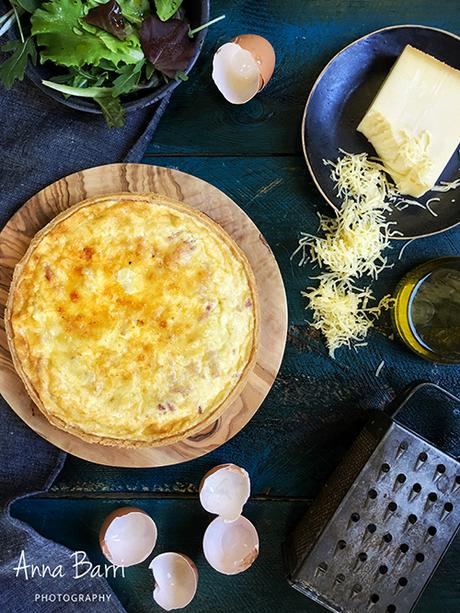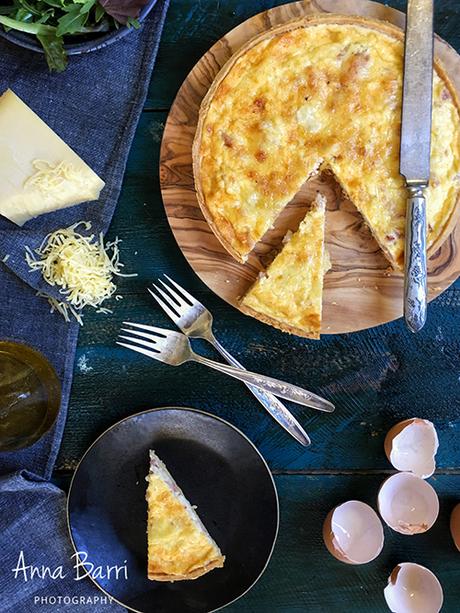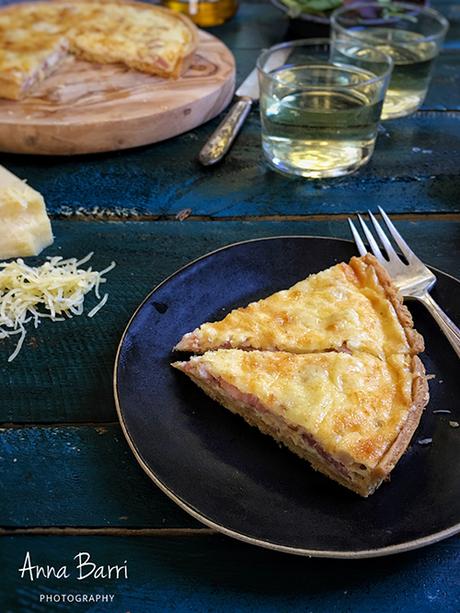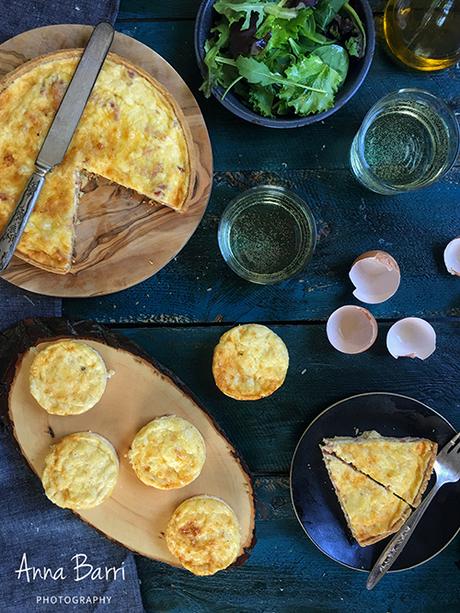Creo recordar que fue mi madre la que me introduzco en el mundo de las quiches. La verdad es que aquí en España, o al menos en Barcelona, es muy difícil de encontrar y de hacerlo normalmente no suelen ser muy ricas o la masa deja mucho que desear.

Creo que debido a esto empecé a odiar la masa de la quiche. Me encantaba el relleno, sobretodo el de la Lorraine que para mi era perfecto, queso Gruyère y bacon ahumado, pero no la masa. Así que normalmente lo que hacía era comerme éste y dejar la masa que se la terminaba mi madre.

No fue hasta que estudié en Le Cordon Bleu que nos enseñaron a hacer una quiche y a partir de ese momento dije, me gusta igual la masa que el relleno. Allí nos enseñaron que la masa debía cuidarse muchísimo, ésta debe enfriarse varias veces para hacer que no se encoja durante el proceso de enfriado, ya que trabajar la mantequilla caliente puede hacer que se deforme. Por otro lado debe estirarse muy fina y cocerse hasta dejarla bien dorada. Esto hace que en la forma sólo notemos una capa fina, crujiente y tostada que pasa muy bien y no se hace nada engorrosa.

Así que aquí os dejo hoy la receta que aprendí en la escuela. Espero que os guste y la pongáis en práctica.
Ingredientes:
Masa:
250 g harina
125 g mantequilla cortada a dados muy fría
5 g sal
60 g huevo
30 ml agua
+ 1 yema con 15 ml de agua para impermeabilizar la masa
Relleno:
300 g tocino ahumado cortado en bastones
80 g de queso Gruyère rallado
3 huevos M
250 g de nata líquida
Sal, pimienta negra y nuez moscada
En un bol juntar harina con sal y la mantequilla, trabajar con una cuerna hasta arenar (debemos ir cortando la mantequilla con la cuerna y mezclándola con la harina hasta que se forme una especie de arena con color a queso). Entonces agregar el huevo y mezclar justo para que se integre. Pasar a la encimera, amasar justo para amalgamar todo, hacer una bola, aplastarla y filmar. Reservar en la nevera por 20 minutos. (Todo este proceso puede hacerse con un robot de cocina utilizando el escudo).
Sacar la masa de la nevera y con un rodillo estirar encima de una superficie un poco enharinada hasta obtener una masa de 2 mm de grosor (es importante que a la que notemos que la mantequilla de la masa empieza a perder frío, la masa está muy blanda, volverla a enfriar, de lo contrario corremos el riesgo de que se encoja durante la cocción).
Una vez estirada la masa en un aro o molde de quiche pintado con mantequilla fundida ponemos la masa, apretándola bien contra la pared y recortando el exceso de masa que sobre por la parte superior. Pinchar la base con un tenedor y volver a enfriar unos 30 minutos más, hasta que esté bien fría.
Precalentar el horno a 180ºC.
Sacar la masa y poner un peso encima para hornear al blanco (yo utilizo film y arroz, ya que el arroz se adapta mejor a todos los rincones del molde). Cocer en el horno a 180ºC durante unos 20 minutos o hasta que la masa empiece a estar cocida. Retirar el peso y cocer hasta que la masa quedé dorada por su base. Sacar, pintar la base con la mezcla de yema y agua y introducir en el horno 10 segundos, justo para secar el huevo. Retirar del horno y poner encima de una rejilla para enfriar completamente.
Mientras saltear el bacon sin nada de aceite en una sartén. Escurrir encima de papel absorbente.
Batir los huevos junto a la nata líquida. Poner sal, pimienta y nuez moscada.
Poner una capa de bacon en la base de la quiche, que quede bien repartido por el fondo. Repartir también por encima una capa de queso Gruyère. Con un cucharón ir rellenando la base con la mezcla de huevos y nata, hasta llegar hasta casi el borde. Hornear a 180ºC durante unos 25-30 minutos, hasta que este dorada y al pinchar con un palillo, éste salga seco. Enfriar encima de una rejilla.
Nota: Si os sobra relleno y no tenéis más masa podéis hornear esté en moldes de silicona pintados con mantequilla. Tendréis unas mini quiche sin masa muy ricas :)

Ingredients:
Dough:
250 g flour
125 g butter, cut in dices and very cold
5 g salt
60 g egg
30 ml water
+ 1 egg yolk with 15 ml water to seal the dough
Filling:
300 g bacon cut into sticks
80 g shredded Gruyère cheese
3 medium eggs
250 g heavy milk
Salt, pepper and ground nutmeg
Put the flour and the salt with the butter in a large bowl. Using a bowl scraper you have to cut the butter while mixing it with the flour, until the dough has a sand texture and cheese color. Then add the egg and mix just to integrate it. Transfer to a floured surface and knead until just combined. Make a ball, cover with clingfilm and reserve it in the fridge until it is very cold, about 20 minutes. (You can do this process in a kitchen robot using the flat beater attachment).
Take the dough out of the fridge and using a rolling pin, extend it on a lightly floured surface until it is 2 mm thick (put it on the fridge to cool if you see than the dough and the butter are starting to be too soft, this is the secret for a good dough, if you work it with the butter too soft the dough will shrink inside the oven). Reserve in the fridge for 20 minutes.
Take it out of the fridge and cover a buttered quiche or round mold with it. Stretch it well over the walls of the mould. Pinch the base with a fork and reserve it in the fridge for 30 minutes or until it is very cold.
Preheat oven to 180ºC.
Cook the base with weight over it (I use clingfilm and rice, because rice suites to all mould corners). Bake for 20 minutes or until cooked. Take out the weight and bake it until the base is golden. Take it out and put it over an oven rack to let it cool completely.
Meanwhile sauté the bacon and reserve it over absorbent paper to remove the excess oil. Whisk the eggs with the heavy cream and add salt, pepper and ground nutmeg.
Put a layer of bacon on the quiche base, covering all the surface. Put over a layer of shredded Gruyère. Using a ladle fill all the quiche with the eggs and heavy cream mixture. Bake it for 25-30 minutes, until the surface is golden and when prick with a toothpick it comes out completely dry. Take it out of the oven and let it cool over an oven rack.
Note: If you have leftover filling but don't have dough, you can cook it inside buttered silicone molds. You will have delicious mini quiches without dough :)

